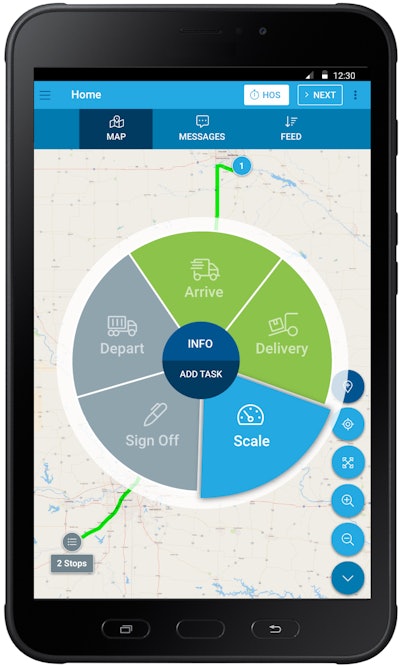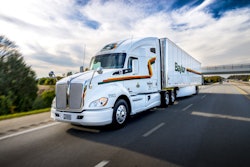 Omnitracs CEO Ray Greer, center, discussed the company’s rollout of the new Omnitracs One platform with CCJ in San Diego at the American Trucking Associations MCE conference.
Omnitracs CEO Ray Greer, center, discussed the company’s rollout of the new Omnitracs One platform with CCJ in San Diego at the American Trucking Associations MCE conference.A few years ago, Microsoft Windows Mobile was still the main platform for in-cab devices in the transportation industry. The migration to Android began slowly but the pace accelerated when the ELD mandate brought new competition to the market.
Tens of thousands of “WinMo” devices are still used by fleets but the end is drawing near.
Ray Greer, chief executive of Omnitracs, estimates the company has 400,000 devices in the field that use the Windows Mobile CE operating system. Those devices are the MCP platform, which the company developed when it was a business unit of Qualcomm, and the IVG device that replaced the MCP from 2016 onward.
Omnitracs now has about 13,000 customers after it added between 1,000 and 2,000 within the last year, said Greer during an interview with CCJ on Oct. 7 at the American Trucking Associations MCE conference in San Diego.
Greer became CEO of Omnitracs in February 2018, less than five years after Vista Equity Partners purchased it in November 2013 from Qualcomm. Before taking the job, Greer asked Vista executives if they would “give me time to do what needs to get done” before selling the company. Vista executives had already tested the market and considered “taking some chips off the table to allow for a minority investment party,” said Greer, “but decided to stay the course.”
Omnitracs’ first-generation IVG platform was shipped with Windows CE but was designed to be updated to Android without removing it from the cab. The MCP devices cannot be updated to Android and will need to be replaced within the next two years, said Greer, since Microsoft will no longer be supporting Windows CE.
 Blue Dot’s MilesAhead software will become the user interface of Omnitracs One.
Blue Dot’s MilesAhead software will become the user interface of Omnitracs One.Omnitracs customers will soon begin migrating to its new Android platform, called Omnitracs One, in January 2020 using their existing IVG devices or any hardware they choose.
“Over time we are becoming hardware agnostic, although we’ll always have a device in the cab when necessary,” he said.
Omnitracs One has been in development for more than a year as a cloud-native platform. With a large customer base, “there is no reason why Omnitracs can’t become the platform for the industry at which everybody innovates on,” he said.
The owner, Vista Equity, “sees that long term vision,” he added. “There are a lot of internal benefits for us as well. We will be able to increase the speed at which we develop and do it at half the cost we did in the past.”
“We are moving on at full speed,” he continued. “Vista is all about product superiority. All they do is invest in software companies. They recognize that product superiority wins out, and they have not slowed us down in R&D. They have been very supportive of that.”
Automating driver workflow
In March 2019, Omnitracs acquired Blue Dot Solutions and has since integrated the driver workflow engine it had developed into Omnitracs One. The automated workflow software will serve up the company’s products, from electronic logs to navigation and messaging, in sequence to drivers exactly when needed.
“The whole point is to automate a driver’s life as they go through their day,” he said. “We are trying to eliminate app fatigue that all these drivers are feeling. We’ve got to make their lives simple.”
Omnitracs One and the driver workflow is designed to integrate with third-party apps as well. Greer says that shippers, such as Amazon, might have apps they want drivers to use when delivering to their locations, and “there is no reason why those apps can’t be part of Omnitracs One.”
The initial release of the new platform will have applications that Omnitracs developed internally, but it will be open to third party app developers as early as mid-2021. “It’s a major transformation for us,” he said.
One of the first fleets to use Omnitracs One is Keenan Advantage Group, the largest tank truck fleet in North America.
Data mining locations
Besides rolling out a new platform, Omnitracs has been focusing on data mining locations where its customers make pickups and deliveries. By looking at time-lapsed data, for example, patterns emerge to identify points where trucks are stacked up on a map. These points indicate entry gates or docks for loading and unloading.
The purpose of mining locations is to gather anonymous data to improve navigation and routing. A geofence — a virtual boundary — can be automatically set at the locations to capture arrivals, departures and to track wait times. Omnitracs has also been able to differentiate wait times and other location data by the type of operation — truckload, expedite and less-than-truckload, Greer said. Omnitracs now has data intelligence on one million locations and Greer expects to eventually surpass two million locations.
With the data intelligence, drivers could have visibility of wait times at stops on their routes, he said, and fleets will have predictive models for arrival times as well as advance visibility of revenue per hour on loads to make planning decisions.
Another area of opportunity for data intelligence is freight matching.
“We are quite interested in partnering with the non-asset community,” said Greer. Omnitracs could add “revenue per hour” and other data intelligence to loads from freight brokers to present to carriers for decision making.











